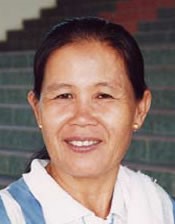Tambanua, Paitan in Malaysia

Photo Source:
Copyrighted © 2026
Southeast Asia Link - SEALINK All rights reserved. Used with permission |
Send Joshua Project a map of this people group.
|
| People Name: | Tambanua, Paitan |
| Country: | Malaysia |
| 10/40 Window: | Yes |
| Population: | 16,000 |
| World Population: | 16,000 |
| Primary Language: | Tombonuo |
| Primary Religion: | Islam |
| Christian Adherents: | 20.00 % |
| Evangelicals: | 5.90 % |
| Scripture: | New Testament |
| Ministry Resources: | Yes |
| Jesus Film: | No |
| Audio Recordings: | Yes |
| People Cluster: | Borneo-Kalimantan |
| Affinity Bloc: | Malay Peoples |
| Progress Level: |
|
Introduction / History
The Paitanic people groups in Sabah include the Tambanua (Tombonuo), Linkabau, Abai Sungai, Upper Kinabatangan, Kalabuan, Dusun Segama, and Sinabu Dusun. Linguistically, the Tambanua and Linkabau are closely related and the Upper Kinabatangan, Kalabuan, Dusun Segama, Sinabu, Lanas Lobu, and Tampias Lobu are similar. The Abai Sungai dialect is not closely related.
The Tambanua is by far the largest. The Tambanua and Linkabau are found in the Beluran (Labuk-Sugut), Pitas, and Kota Marudu districts in northern Sabah. The Abai Sungai are found along the lower Kinabatangan river in the eastern part of the Kinabatangan district. The Tampias Lobu are found in three villages in Ranau around the town of Tampias. The Upper Kinabatangan, Dusun Segama, and Sinabu are primarily along the upper reaches of the Kinabatangan River. The Lanas Lobu (including Rumanau) are found in the Keningau and Kinabatangan districts.
What Are Their Lives Like?
Most of the Tambanuas are farmers with rice being the most important crop. The family and the village are the basic structures around which these peoples center their lives. Families provide for most of their individual needs by rice farming or fishing and equally sharing the work load. The family has the use of village land based on its residence in the village, but it does not actually own the land.
One of the distinguishing features of many villages is their role as a ceremonial unit. Ceremonies are performed for the health and welfare of an individual, a family, and the village as a whole. During some ceremonies, the village pathways are sealed off and outsiders kept away to ensure trespassing does not disturb those spirits.
What Are Their Beliefs?
Traditionally these peoples were animists, although both Christianity and Islam have taken root. Animistic practices have become intertwined with Muslim customs in some villages. Allah is thought to be incomprehensible and unreachable, while demons are in contact with man daily. Shamans use chicken sacrifices in an attempt to placate these spirits when their displeasure becomes apparent in the form of sickness.
Christian outreach has made progress through means of community development and education. Muslim outreach carries out similar activities, such as working in wet rice production and cash crop expansion, to expand the influence of their religion. Animistic practices still exert a powerful influence even over those professing to be Christian or Muslim. Most of the important village ceremonies are attended by all, regardless of religious affiliation. Christian substitutes for harvest, fertility and village renewal ceremonies have not been widely accepted and most villagers still are active in traditional rituals associated with animism.
What Are Their Needs?
Community development work is seen as a viable way to bless the community and to help these groups adapt to their changing world.
Prayer Points
Pray that believers will provide health care, nutrition, literacy, and agriculture programs, while at the same time be able to share the truth of the good news.
Pray for the Lord to abundantly provide for them spiritually and economically.
Pray that soon the Tambanuas will be discipling new believers and preparing them to disciple others.